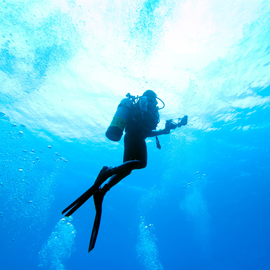Navigating with the Underwater World
Posted: Apr 25 in Dive Blog tagged Specialty Diving by Jan Though a compass or GPS can make navigation easy, you don’t have to rely on these tools to find your way around underwater. Like an ancient mariner guided by nothing more than the stars of the night sky, you can use details in the world around you as natural navigational references on any dive. After you get your scuba certification in Illinois, learning the best way to follow these natural landmarks can help you know where you are and how to get to where you’re going.
Though a compass or GPS can make navigation easy, you don’t have to rely on these tools to find your way around underwater. Like an ancient mariner guided by nothing more than the stars of the night sky, you can use details in the world around you as natural navigational references on any dive. After you get your scuba certification in Illinois, learning the best way to follow these natural landmarks can help you know where you are and how to get to where you’re going.
Like any successful dive, your preparations for natural underwater navigation should begin above the water. Start by making observations of:
- The angle of the sun. Look at where the sun sits in relation to your intended direction of travel. During any day dive, you will usually be able to see the sun, even in murky water.
- The depth finder. If the boat you’re diving from has one, a depth finder can show you underwater formations and the contours of the bottom.
- Offshore landmarks. Take note of objects you can see from the surface, like buoys, piers and reefs. If you see waves breaking offshore, there may be a sandbar or shallow reef.
- Currents, tides and waves. Use tide tables and watch floating debris to know which way the water is flowing. This way, you can orient yourself by swimming with or against the flow.
As you begin to descend, keep your feet below head level to stay oriented. Point yourself in the direction you’re headed and pay attention to the current’s speed as you go deeper. Now you can begin to note natural underwater references like:
- Shadows. The sun itself can be a navigational asset, but it will also cast directional shadows, especially in the morning and late afternoon. Note the direction of underwater shadows relative to your route. If you begin your dive with the sun on your right and shadows to your left, you can use this information to reorient yourself.
- The bottom. On every dive, the bottom can have distinct and changing features that help you find your way. Even if the bottom’s composition stays more or less the same, formations like sand ripples can guide you—these always form perpendicular to the flow of water, so you can swim perpendicular to them to head towards or away from shore. You should also take note of contour. Follow natural slopes to deeper water and use reefs, ridges, kelp beds and other objects to follow natural paths by keeping them to your right or left.
- Flora & fauna. Because underwater organisms prefer specific living conditions, they can provide clues about your surroundings. Some only live at specific depths, while others, like the sea fan, tend to grow perpendicular to the current. Though you’ll likely need some training as a fish identifier and underwater naturalist to take advantage of information like this, it can be a big help.
Though wrist-mounted GPS and other pieces of modern scuba equipment have brought underwater navigation into the 21st century, learning to navigate with the world around you can keep your attention focused on what you’re diving to see: the exciting environment around you.
